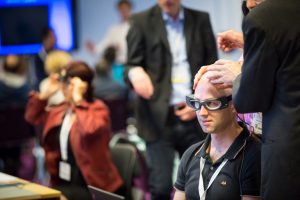The second annual congress of the European Academy of Neurology (EAN) was held in the Bella Centre in the beautiful city of Copenhagen, Denmark between 28th and 31st May 2016.
During the 4-day congress, more than 5500 delegates hailing from Europe and the far reaches of the globe came together in order to discuss cutting edge science in the growing field of neurology, learn about new advances, future projects, exchange experiences and build new collaborations.
The congress programme included a plenary symposium, teaching courses, case-based facilitated workshops, hands-on courses, focused workshops, interactive sessions, special sessions, career development sessions and satellite symposiums.

The symposia focused on updates on neuroimaging in relation to dementia, on movement disorders including tremors, idiopathic and atypical forms of Parkinson’s disease, on the indication for and use of deep brain stimulation, on recovery of consciousness following severe brain damage, on diagnosis and treatment modalities of both high and low grade gliomas, on some neuromuscular diseases with a focus on therapeutic approaches and possible perspectives, on acute stroke, on potential usefulness of fMRI, on diagnostic definitions and techniques in epilepsy patients, on inflammatory and degenerative aspects of multiple sclerosis and finally, on the role of calcitonin gene related peptide (CGRP) in the context of migraine.
Besides the outstanding lectures, 1500 researchers had the opportunity to present and expose their research to a wide audience during the guided electronic poster sessions as well as via oral presentations which stimulated vivid discussions.
The EAN congress also offered an interesting programme focusing on the needs of junior scientists and clinicians. Knowledge involving the many aspects of neurology was delivered during excellent teaching courses and, as a new initiative, the EAN introduced focused workshops where key topics were discussed such as questions or single best answer writing in order to improve the skills of the next generation of clinicians and researchers within the field of neurology.
Furthermore, in order to encourage research, outstanding researchers were honoured during the EAN with a prize for the best presentations during the clinical and scientific tournaments. The P. K. Thomas Prize as well as the investigator awards can be seen online: www.eaneurology.org
For the first time the EAN has introduced the “EAN named lectures” during the presidential plenary symposium in order to honour outstanding scientists in the field of neurology. The lectures were held in recognition of three famous European scientists in neurology; namely Moritz Heinrich Romberg, Camillo Golgi and Charles-Éduard Brown-Séquard. Out of more than 70 nominations, the EAN Board selected Professor Eduardo Tolosa Sarro to lecture about “the pre-diagnostic phase of Parkinson’s disease”, Giacomo Rizzolatti about “The mirror mechanism: social and medical implications” and Professor Thomas Brandt about “3-D Spatial Memory and Navigation: Functions and Disorders.”
Another highlight during the congress was the breaking news session which was dedicated to ‘epidemiology, clinical presentations and immunology of Zika-Virus induced neurological diseases.’
Besides the scientific programme, The EAN also offered networking events. After the opening day, the delegates enjoyed a live performance by star dancers of the Royal Danish Ballet performing scenes from Swan Lake by Tchaikovsky. This year’s networking evening brought delegates to a street food market in the heart of Copenhagen where they could mingle while trying a wide variety of different cuisines.
EAN, as the home of neurology in Europe, continuously works on expanding their interactions with different societies and once more, during this second congress of EAN, new collaborations have been built and signed. (www.eanpages.org)
In conclusion, this meeting brought together clinical neurologists and basic neuroscientists from all around the world and provided highlights from clinical and basic science. It was certainly an excellent educational platform for all who attended.